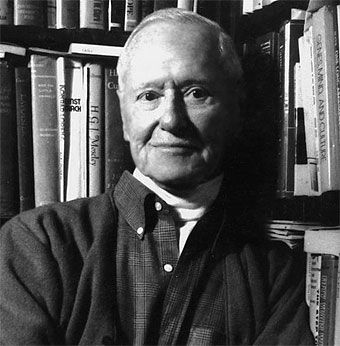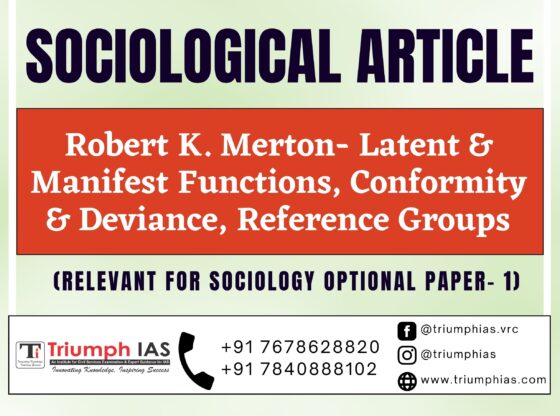Robert K. Merton- Latent & Manifest Functions, Conformity & Deviance, Reference Groups
Relevant for sociology optional Paper- 1 (Unit- 4 : Sociology- Sociological Thinkers)

Robert K. Merton was a sociologist who made significant contributions to the field of sociology. He was born on July 4, 1910, in Philadelphia, Pennsylvania. He completed his undergraduate studies at Temple University and received his Ph.D. from Harvard University. Merton is best known for his work on the concepts of latent and manifest functions, conformity and deviance, and reference groups.
Latent and Manifest Functions: Merton developed the concept of latent and manifest functions as a way to explain the unintended consequences of social actions. Manifest functions are the obvious, intended consequences of social actions, while latent functions are the unintended, often hidden consequences of social actions. For example, the manifest function of education is to provide knowledge and skills to individuals. However, the latent function of education is to provide socialization and conformity to societal norms.
Merton also developed the concept of dysfunction, which is the negative consequences of social actions. Dysfunction can be caused by both manifest and latent functions. For example, the manifest function of a prison is to punish criminals and deter crime. However, the latent function of a prison is to stigmatize and isolate individuals, which can lead to more deviant behaviour.
Conformity and Deviance: Merton believed that society puts pressure on individuals to conform to societal norms and values. Conformity is the act of adhering to societal norms and values, while deviance is the act of violating societal norms and values. Merton developed the strain theory to explain why individuals engage in deviant behaviour. The strain theory suggests that individuals who experience strain or stress are more likely to engage in deviant behaviour.
Merton identified five different types of deviance: innovation, ritualism, retreatism, rebellion, and conformity.
- Innovation is the act of using unconventional means to achieve conventional goals. For example, a person who sells drugs to make money is engaging in innovation.
- Ritualism is the act of adhering to societal norms and values without achieving conventional goals. For example, a person who goes to work every day but does not aspire to move up the corporate ladder is engaging in ritualism.
- Retreatism is the act of rejecting societal norms and values and withdrawing from society.
- Rebellion is the act of rejecting societal norms and values and actively working to change them.
- Conformity is the act of adhering to societal norms and values and achieving conventional goals.
Reference Groups: Merton also developed the concept of reference groups, which are groups that individuals use as a standard for evaluating their own behaviour and attitudes. Reference groups can be real or imaginary and can be positive or negative. For example, a person may look up to a successful businessperson as a positive reference group or a criminal as a negative reference group.
Merton identified two different types of reference groups: aspirational and dissociative.
- Aspirational: Robert K. Merton developed the concept of reference groups, which are groups that individuals use as a standard for evaluating their own behaviour and attitudes. Merton identified two different types of reference groups: aspirational and dissociative. Aspirational reference groups are groups that individuals aspire to be like. These groups often represent a desirable future for the individual and can serve as a source of motivation. For example, a person who wants to become a successful businessperson may look up to a successful entrepreneur as an aspirational reference group. Aspirational reference groups can be positive and can inspire individuals to achieve their goals.
- Dissociative: dissociative reference groups are groups that individuals do not want to be like. These groups often represent a negative future for the individual and can serve as a source of fear or avoidance. For example, a person who wants to avoid a life of crime may look at criminals as a dissociative reference group. Dissociative reference groups can be negative and can cause individuals to avoid behaviours or attitudes associated with the group.
It is important to note that reference groups can change over time and can vary depending on the individual’s experiences and circumstances. For example, a person who initially looked up to a successful businessperson as an aspirational reference group may later view that person as a dissociative reference group if they become disillusioned with the businessperson’s practices or values.
In conclusion, Robert K. Merton made significant contributions to the field of sociology through his work on the concepts of latent and manifest functions, conformity and deviance, and reference groups. His work has helped to explain the unintended consequences of social actions, the pressure to conform to societal norms and values, and the impact of reference groups on individuals’ behaviour and attitudes. Merton’s work continues to be relevant today and has influenced the development of many other sociological theories and concepts.
For more such notes, Articles, News & Views Join our Telegram Channel. https://t.me/triumphias
Click the link below to see the details about the UPSC –Civils courses offered by Triumph IAS. https://triumphias.com/pages-all-courses.php


